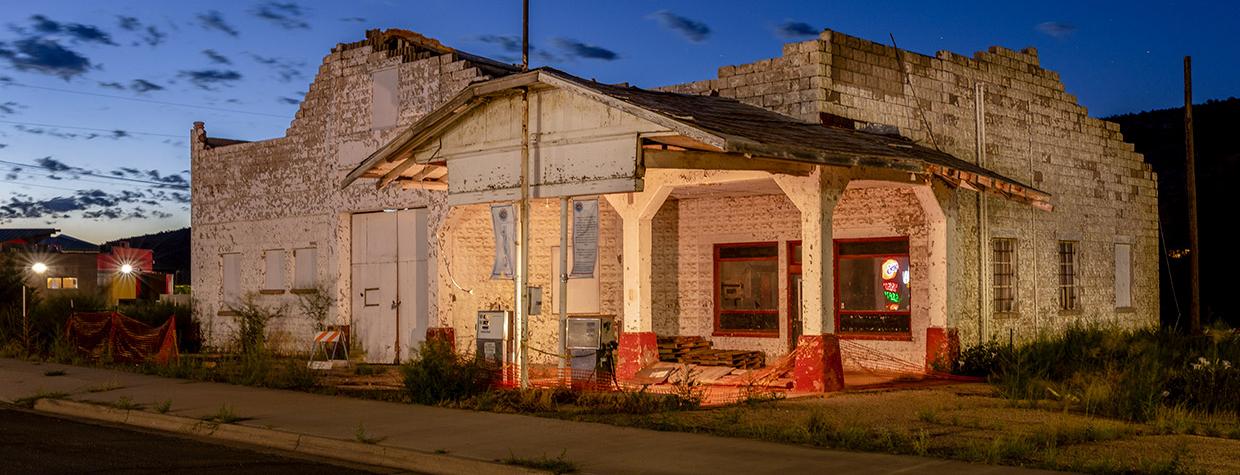Many members of the Hualapai Tribe have memories of the old gas station near the corner of Historic Route 66 and Diamond Creek Road. For tribal Chairwoman Sherry Parker, one memory is the strongest.
“I remember the smell — it was like oil,” says Parker, who’s lived in the tribe’s capital of Peach Springs for most of her life. “When I was maybe 11 or 12, we used to go in there. They would sell candy and soda, and there were people working on tires and doing mechanic stuff. And I remember the cigarette machines that were there — back when cigarettes were 25 cents a pack. But I’ll always remember that smell.”
Memories could soon be all that are left of the Osterman Gas Station, which helped make Peach Springs a Route 66 destination and an important stop on the way to the Grand Canyon. It’s been shuttered for decades and damaged by recent storms, and without preservation and restoration, it might collapse or face the wrecking ball. This year, that uncertainty led the National Trust for Historic Preservation to include the station on its annual list of “America’s 11 Most Endangered Historic Places,” a designation intended to raise awareness of threats facing such places.
Amy Webb, the National Trust’s senior director of preservation programs, says the structure is “a quintessential Route 66 gas station” and one of the only buildings from that era remaining in Peach Springs. The trust, she adds, seeks to make preservation more equitable and draw attention to lesser-known places, which helped make the station an ideal fit for the highly competitive list.
The Osterman family of Swedish immigrants built the station in the late 1920s from a concrete-block kit they bought from a Sears, Roebuck and Co. catalog. (Those things really did have everything.) During Route 66’s heyday, it was one of five gas stations in Peach Springs, and Parker remembers busloads of tourists making photos of the station and other sights in town.
And while most of the station’s customers were motorists, in the summer of 1931, a very different kind of visitor wandered in. He was one of two men who had found a boat along the Colorado River and attempted to pilot it through the Canyon to the Boulder Dam (now Hoover Dam) construction site, where both men had worked.
The man, Oscar Osterman recalled to the Associated Press, was “seeking aid to locate a companion, whom he said he left on the ledge of the Colorado River after their boat overturned.” The man had climbed to the rim of the Canyon, then walked some 20 miles before reaching Peach Springs. “We organized a searching party of seven men but were unsuccessful in finding the man,” Osterman added — and neither the missing man nor the boat was seen again.
Now, the Hualapai Tribe owns the station and is hoping to save it from a similar fate. While Peach Springs remains a hub for Canyon rafting and hiking trips, the completion of Interstate 40 decimated Route 66 traffic, leading to the station’s closure in the 1990s. The COVID-19 pandemic slowed restoration efforts, a microburst in 2021 tore the roof off the building, and a windstorm this past February caused one of the walls to collapse.
Ideas for reviving the building have included making it a museum or again using it as a gas station and repair shop, but Parker hopes to see the station’s exterior restored and its interior turned into a place for tribal members to sell their pottery, jewelry and other crafts.
Any restoration will require funding, and inclusion on the National Trust’s list could help secure it. Last year’s list included Camp Naco, a Southeastern Arizona site related to the history of the Buffalo Soldiers; that site subsequently received more than $8 million in restoration funding from the state (via the federal American Rescue Plan Act) and the Mellon Foundation.
Since this year’s list was released, the Hualapai Tribe has received money to stabilize the station. Webb, who heads the National Trust’s ongoing Route 66 preservation initiative, is optimistic that future funding will enable the building to be fully restored by the time Route 66 celebrates its centennial in 2026. And Governor Katie Hobbs has signaled her support, saying in a press release that the station is “an important piece of Americana” that “can once again serve as a meaningful piece of the Peach Springs revitalization plans of the Hualapai Tribe.”
The Osterman Gas Station’s next iteration might not feature 25-cent cigarette packs or the smell of oil, but Parker is looking forward to making the building a destination again. “It’s a centerpiece of our history and a part of everyone’s memory,” she says. “Restoring it would really give us the opportunity to show it off and show the history of who we are.”
PEACH SPRINGS Hualapai Tribe, hualapai-nsn.gov

